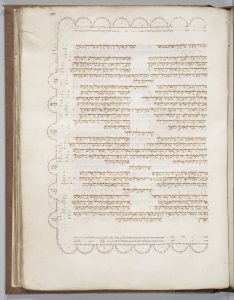
When the Torah is read in the synagogue, there is a distinct tune that is used for the traditional chanting. It is called cantillation in English, trop in Yiddish and te’amim in Hebrew, and is indicated in the Hebrew Bible by various symbols above and below the letters. Medieval manuscripts often included the masorah, a commentary which discussed aspects of the letters and their chanting, and sometimes described hidden meanings within the text. (A well-known example of a commentary on a cantillation mark is the shalshelet on the word “and he lingered” during the story of Lot’s flight from Sodom. The shalshelet draws out the word, indicating, according to some commentaries, that Lot lingered far longer than he should have before fleeing the burning city.)
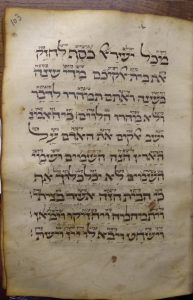
Throughout the centuries, Jews used various methods for studying the trop in preparation for reading from a Torah scroll, or as they reviewed the Bible text as part of study. A fourteenth century prayer book from France (left) shows a selection of verses from various parts of the Hebrew Bible which include the different te’amim, and could be used as a kind of sampler to study the notes for reading the Torah. The scribe of the prayerbook wrote out the names of the individual sounds along with the symbols so that a student could learn and practice with them.
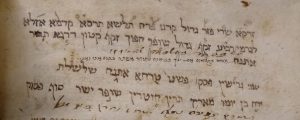
The trop is closely connected to the grammar and meaning of a word, and often impacts its pronunciation (especially with respect to which syllables are emphasized). In Hebrew, for example, some letter sounds change depending on the letter preceding it (similar to how, in English, a c is hard or soft depending on the following vowel). It is thus not surprising that the owner of Leshon Limudim, a grammar book printed in Constantinople in 1506, wrote the names of the cantillation marks before the start of the printed text, along with the notation marks for them. The owner was either Italian or of Italian descent, evidenced by his writing the order of the cantillation marks in the manner unique to the Italian tradition. (My thanks to Dr. David Spitzer, who identified this particular arrangement as Italian.)
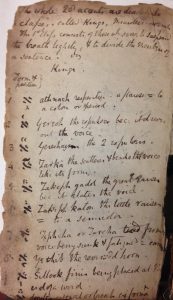
Christian scholars of Hebrew also displayed an interest in the manner in which Jews chanted the Bible. The manuscript on the left was written on the flyleaves of a book of Psalms, and includes a written description (in English) of each cantillation mark and its sound. Before each description is the Hebrew letter aleph (א), with the relevant mark either above or below it. These annotations are clearly made by a student of the trop, who wrote both a literal translation of the names as well as a description of the sound produced. The first six descriptions are transcribed below.
- athnach resporator [?]. a pause = to a colon or period.
- Geresh the expulsor bec. it drives out the voice
- Gershayim the 2 expulsions
- Zarka the scatterer. It bends the voice like its form
- Zakeph gadol the great raiser, bec. it elevates the voice.
- Zakeph katon the little raiser = to a semicolon
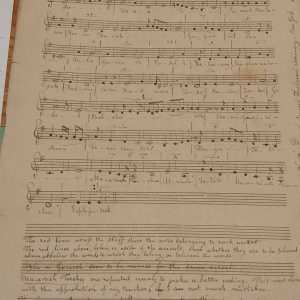
Another example of Christian interest in the chanting of the Torah is evidenced by a manuscript by Clement C. Moore of the General Theological Seminary in New York, written in 1839. Moore visited a “Portuguese” congregation (likely She’erith Israel) in New York to record the “Hebrew chant of the Jews in singing the Law.” As a scholar of music, he recorded the cantillation according to musical notation. Moore pointed out in his notes that “German Jews have a different gamut,” observing that versions of the trop as sung by Jews from different lands (even within Europe) have distinctive variation. Interestingly, he also wrote that “the Jews do not appear to be strictly bound to the same number of notes,” perhaps noting that the chanting of the Torah differed slightly depending on the time or reader.
A person learning to chant the Torah today has a myriad of options from which to choose – there are books, audio, and even apps that one can use to study the symbols and their sounds. While students of Torah cantillation in the past were limited to written media, the options looked quite different in different times and places, as in this brief sampling from within Columbia’s Judaica collections.
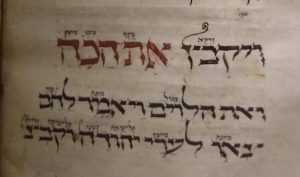
i am searching for a recording of the tune for the torah portion of haazeenu in yiddish. can you help?
I’m afraid I am not aware of such a recording. The Torah is usually chanted in the original Hebrew, not in translation.
Regarding the photo accompanying these remarks:
“The manuscript on the left was written on the flyleaves of a book of Psalms, and includes a written description (in English) of each cantillation mark and its sound.”
It is interesting that although some of the marks hand-noted there are shared between the prose & poetic cantillation systems, some are specific to the prose cantillation system, and none are specific to the poetic system. I.e. these notes may have been written on the flyleaves of a book of Psalms, but they contain notes on accents you will not find in Psalms, and contain no notes on accents you will only find in the poetic books like Psalms!
Yes, I hadn’t thought of that! It’s kind of ironic indeed.